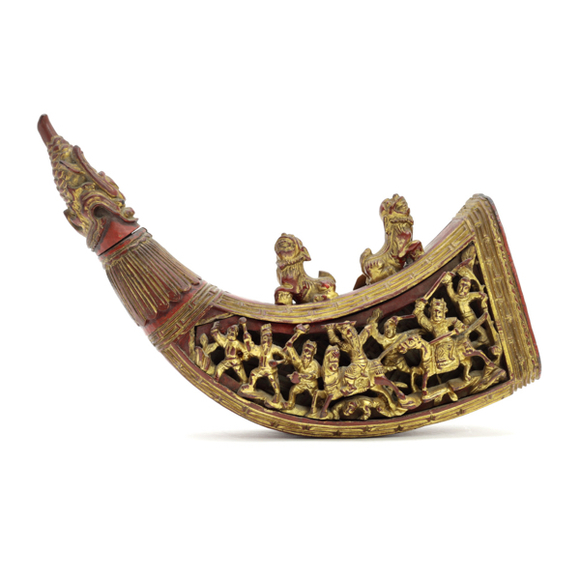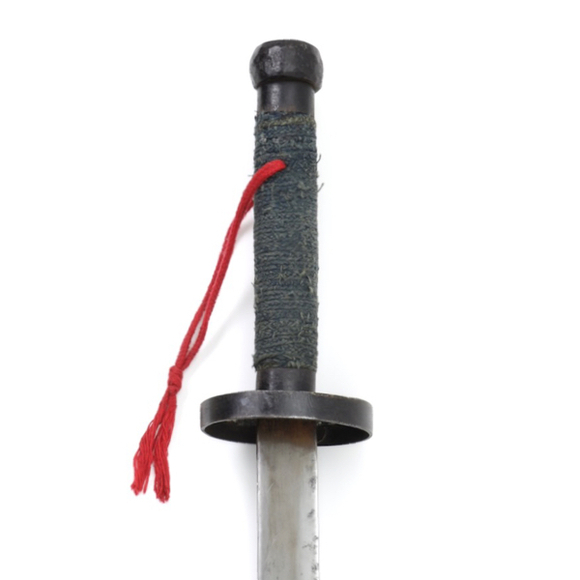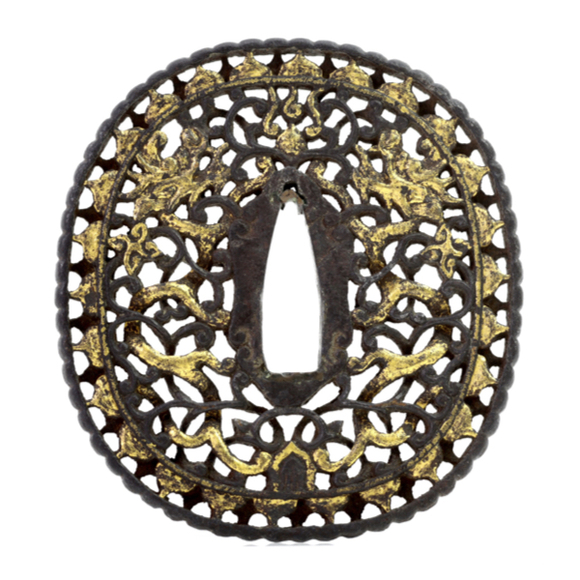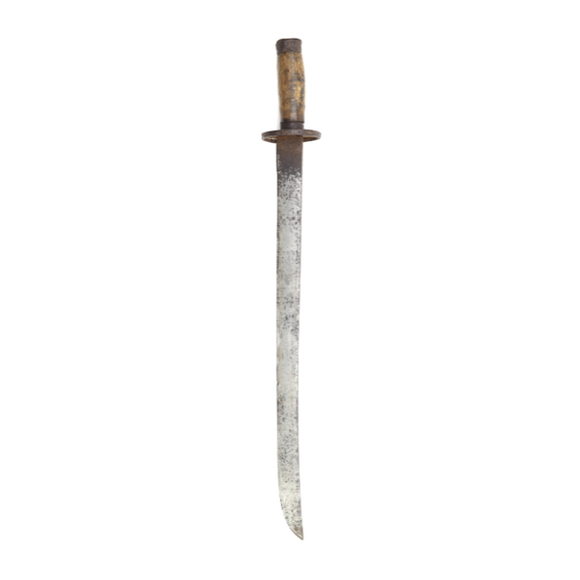With a golden damascened lock of the Indo-Portuguese type.

Sheathed 47.2 cm
Knife 37 cm
26.1 cm
Base 5 mm
Middle 3.5 mm
Base 31.5 mm
Sheathed 431 grams
Dagger 269 grams
At blade-hilt junction
Steel, nephrite jade, wood, silver, leather
Qing Imperial Court of Beijing
Late 18th - early 19th century
European antique art market
Introduction
The oasis town of Hotan was a famous center of trade for the finest jade found in Asia, the nephrite jade of the nearby Kunlun mountains. The best was the white opaque "mutton fat" jade, which was highly prized from East to West by the Ottomans, Persians, Indians, and Chinese. The mines are now almost exhausted, producing only a few kilos of the (still prized) material annually.
After the Qianlong emperor's troops had occupied Hotan during the Xinjiang campaigns of 1758–1759, his officials sent back all kinds of fine jade articles, among others nephrite jade dagger hilts intended for the Indian Mughal court. The presence of finished products indicates that skilled jade carvers probably had settled there locally, probably to secure the first pick of the best jade at the best prices.1
The emperor loved them, and called the unknown workers who made these items his Guǐgōng (鬼工), literally: "ghost workers." In some poems he even alluded that they were made by immortals. He ordered the production of many swords and daggers with fine jade hilts to be made. Apparently, some even came with blades but he ordered them to be melted down, and replaced with blades made by his own workshop.2
The Qianlong emperor's preference for Islamic jades from Hotan meant less work for his jade carvers in China. By 1778, some Southern Chinese jade carves had moved to the Yarkand region in Xinjiang to continue to work there. They produced both for the local market and took commissions from Qing officials, some of which were intended for the Qing court. Eventually, the Qing court workshops also started to produce items in this style.3
Notes
1. Teng Shu-p'ing; Exquisite Beauty: Islamic Jades. National Palace Museum, 2007.
2. Ibid. Page 258. Many jade hilted swords and daggers are preserved in the Palace Museum in Beijing, published among others in: 故宫博物院藏文物珍品全集 56: 清宫武备 (Gugong Bowuyuan Cang Wenwu Zhenpin Quanji 56: Qing gong Wubei) or "The Complete Collection of Treasures of the Palace Museum, Beijing 56: Armaments and Military Provisions", Palace Museum, Beijing. Published Hong Kong 2008.
3. Teng Shu-p'ing; Exquisite Beauty: Islamic Jades. National Palace Museum, 2007. Page 278.
This example
An extremely rare and interesting dagger, made in the Qing court workshops of the late Qianlong to early Jiaqing period.
It features the typical blade for these with two shallow but wide grooves, a lightly recurved blade with a very subtle narrowing of the spine from around halfway down the blade length. The steel structure is different from typical Chinese steel, which makes me wonder whether it was made from recycled Indian steel. It has a very high-pitched ring to it. The blade is mounted to the hilt by means of a small tang being inserted into the jade, just like the Mughal daggers.
The hilt is made of fine, pale green nephrite jade. Its proportions and the "rolling thunder" motifs carved into the hilt identify it as being of Chinese manufacture, but the fine jade is of the type sourced almost exclusively in the Kunlun mountains.
The scabbard is made of tree pieces of wood, two side plates with a third closing off the top. It is entirely covered with a once golden yellow leather, when new, it was probably the imperial golden yellow (金黃). This color was for exclusive use by the emperor and his innermost circle, and people of merit who earned the right to use it by imperial decree.

The scabbard has two silver mounts, carved in relief with stylized floral designs. These unusual motifs are almost exclusively seen on the group of jade-hilted daggers made in the imperial workshops. The mouthpiece is further carved with rolling thunder designs, like the jade hilt.
Comparable examples
As mentioned, a number of sabers and daggers were produced by the imperial workshops using jade hilts, either those originally intended for the Mughal court or those inspired by them.
Many of the daggers have red leather-covered scabbards with gilt copper alloy mounts, their show similarity to some swords in the "Earth" (地) series of 30 swords commissioned by the Qianlong emperor and undoubtedly date from his reign. Judging from the workmanship of some others, I believe production may have continued somewhat into the Jiaqing reign of 1796 to 1820, but not much later.

Our dagger on the Palace Museum Beijing publication titled 故宫博物院藏文物珍品全集 56: 清宫武备.
It shows two gilt copper-mounted daggers of this series.
Silver-mounted ones are very rare, but one is preserved in the National Palace Museum in Taipei. Hilt in Mughal style, but the proportions tell me it's probably Chinese:

National Palace Museum Taipei
Accession number Guyu 006103N000000000.
Another, with a scabbard color much similar to ours, I found in the British Museum reserve collection. It is erroneously attributed as being Mughal or Iranian. The scabbard color is very similar, if not identical, to the subject of this article. The hilt is Mughal-styled, but I believe it is Chinese-made as well. It has a separate silver band with rolling thunder carvings, echoing that of the scabbard mouthpiece:

British Museum, London, accession number 1878,1230.880
Bequest of John Henderson, acquired 1878.
Conclusion
The group of jade-hilted court daggers shows great variety, often taking foreign parts or ideas into their designs. We don't really know why they were made, and for how long, but I suspect production went on a little while after Qianlong's reign into the Qiaqing reign. Most were probably intended as court playthings, others were probably made to serve as gifts.
It is interesting to note that they do not tend to have suspension mounts like even the smallest of traditional Chinese daggers seem to have. They were either meant to be worn thrust through a belt, or not worn at all.
Another thing I noticed from handling a few of them over my career is that the ones with the wide grooves, like this example, tend to have an unusually high-pitched ring to them and show a steel structure that is not Chinese-looking. Palace records speak of "melting down" Indian blades, and I suspect these may have been re-forged out of that steel. The Indian patterns would go lost in the process, but the foreign look and ring to them were probably exotic enough for the intended audience.
Another mystery is how few of the silver-mounted ones are in collections. I tend to think the gold-mounted ones were mainly imperial playthings, like the similarly mounted group of jiàn made for the Qianlong emperor's own enjoyment. Perhaps the yellow scabbard, silver mounted pieces were meant as gifts. Their execution is certainly more modest than that of the emperor's own toys, but stylistically, the mounts are identical, and imperial yellow was not a color that was taken lightly in imperial China.
A rare and fascinating dagger, part of a small group that is mostly in notable museum collections.



















Probably of Southern origin, with a straight blade and flaring tip.
In the style of northern work of the 16th and 17th centuries
A standard pattern Qing military saber, but with the rare addition of a label in Manchu.






